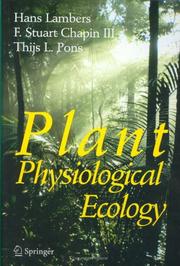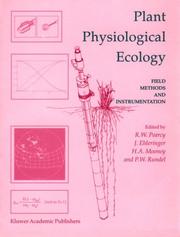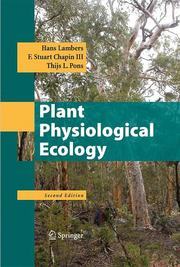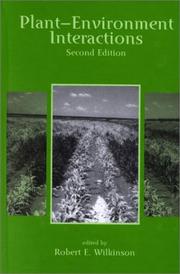| Listing 1 - 10 of 367 | << page >> |
Sort by
|
Book
ISBN: 9780470989258 0470989254 9780470989258 0470989254 Year: 1976 Publisher: New York: Wiley,
Abstract | Keywords | Export | Availability | Bookmark
 Loading...
Loading...Choose an application
- Reference Manager
- EndNote
- RefWorks (Direct export to RefWorks)
Book
ISBN: 0443159394 Year: 2024 Publisher: London, England : Elsevier Inc.,
Abstract | Keywords | Export | Availability | Bookmark
 Loading...
Loading...Choose an application
- Reference Manager
- EndNote
- RefWorks (Direct export to RefWorks)
Book
ISBN: 9780199540952 9780199540945 0199540950 0199540942 Year: 2012 Volume: 4 Publisher: Oxford : Oxford University Press,
Abstract | Keywords | Export | Availability | Bookmark
 Loading...
Loading...Choose an application
- Reference Manager
- EndNote
- RefWorks (Direct export to RefWorks)
Fishes --- Ecophysiology --- Ecophysiology. --- Fishes - Ecophysiology

ISBN: 0387983260 9780387983264 Year: 1998 Publisher: New York (N.Y.) : Springer,
Abstract | Keywords | Export | Availability | Bookmark
 Loading...
Loading...Choose an application
- Reference Manager
- EndNote
- RefWorks (Direct export to RefWorks)

ISBN: 9780412407307 0412407302 Year: 2000 Publisher: Dordrecht: Kluwer,
Abstract | Keywords | Export | Availability | Bookmark
 Loading...
Loading...Choose an application
- Reference Manager
- EndNote
- RefWorks (Direct export to RefWorks)

ISBN: 9780387783406 9780387783413 0387783407 Year: 2008 Publisher: New York, NY Springer New York
Abstract | Keywords | Export | Availability | Bookmark
 Loading...
Loading...Choose an application
- Reference Manager
- EndNote
- RefWorks (Direct export to RefWorks)
The growth, reproduction, and geographical distribution of plants are profoundly influenced by their physiological ecology: the interaction with the surrounding physical, chemical, and biological environments. This textbook describes mechanisms that underlie plant physiological ecology at the levels of physiology, biochemistry, biophysics, and molecular biology. At the same time, the integrative power of physiological ecology is well suited to assess the costs, benefits, and consequences of modifying plants for human needs and to evaluate the role of plants in ecosystems. Plant Physiological Ecology, Second Edition is significantly updated, with full color illustrations and begins with the primary processes of carbon metabolism and transport, plant water relations, and energy balance. After considering individual leaves and whole plants, these physiological processes are then scaled up to the level of the canopy. Subsequent chapters discuss mineral nutrition and the ways in which plants cope with nutrient-deficient or toxic soils. The book then looks at patterns of growth and allocation, life-history traits, and interactions between plants and other organisms. Later chapters deal with traits that affect decomposition of plant material and with the consequences of plant physiological ecology at ecosystem and global levels. Plant Physiological Ecology, Second Edition features numerous boxed entries that extend the discussions of selected issues, a glossary, and numerous references to the primary and review literature. This significant new text is suitable for use in plant ecology courses, as well as classes ranging from plant physiology to plant molecular biology. From reviews of the first edition: ". . . the authors cover a wide range of plant physiological aspects which up to now could not be found in one book. . . . The book can be recommended not only to students but also to scientists working in general plant physiology and ecology as well as in applied agriculture and forestry." - Journal of Plant Physiology "This is a remarkable book, which should do much to consolidate the importance of plant physiological ecology as a strongly emerging discipline. The range and depth of the book should also persuade any remaining skeptics that plant physiological ecology can offer much in helping us to understand how plants function in a changing and complex environment." - Forestry "This book must be regarded as the most integrated, informative and accessible account of the complexities of plant physiological ecology. It can be highly recommended to graduate students and researchers working in all fields of plant ecology." - Plant Science ". . . there is a wealth of information and new ideas here, and I strongly recommend that this book be on every plant ecophysiologist's shelf. It certainly represents scholarship of the highest level, and many of us will find it a useful source of new ideas for future research." - Ecology

ISBN: 1572921099 9781572921092 9781572921085 1572921080 Year: 1998 Publisher: San Francisco (Calif.): Austin & Winfield,
Abstract | Keywords | Export | Availability | Bookmark
 Loading...
Loading...Choose an application
- Reference Manager
- EndNote
- RefWorks (Direct export to RefWorks)
Book
ISBN: 9781138506381 1032095733 9781032095738 1138506389 Year: 2018 Publisher: Boca Raton: CRC,
Abstract | Keywords | Export | Availability | Bookmark
 Loading...
Loading...Choose an application
- Reference Manager
- EndNote
- RefWorks (Direct export to RefWorks)

ISBN: 0824703774 Year: 2000 Publisher: New York (N.Y.) : Dekker,
Abstract | Keywords | Export | Availability | Bookmark
 Loading...
Loading...Choose an application
- Reference Manager
- EndNote
- RefWorks (Direct export to RefWorks)
Book
Year: 2023 Publisher: Basel : MDPI - Multidisciplinary Digital Publishing Institute,
Abstract | Keywords | Export | Availability | Bookmark
 Loading...
Loading...Choose an application
- Reference Manager
- EndNote
- RefWorks (Direct export to RefWorks)
Air pollution and the changing climate are some of the greatest threats to the health and functioning of forest ecosystems, strongly jeopardizing their ecological and economic functions as well as services. The impact of increasing temperatures and extreme weather events (droughts, storms, temperature and precipitation extremes) on the vitality of forest trees is often difficult to separate from the impact of pollution, such as nitrogen deposition and tropospheric ozone, as they can exhibit synergistic effects. The use of indicators is elementary in modern forest ecophysiological research, as they help us to disentangle complex interactions between trees and various stress-inducing factors as well as better estimate the level of damage to trees and forest ecosystems.Eleven papers are included in this Special Issue, with wide-ranging topics from various disciplines but centered around tree responses to environmental stress. The task of this Special Issue is twofold: one, to remind us that a better understanding of the physiological processes influencing tree vitality under the changing climate and air pollution pressures requires considerable research efforts and constant advancements in research methods and approaches; two, to highlight the fact that the environmental pressures instigating the use of tree stress response indicators are more present than ever, and will likely continue to affect tree vitality in the foreseeable future.
| Listing 1 - 10 of 367 | << page >> |
Sort by
|

 Search
Search Feedback
Feedback About UniCat
About UniCat  Help
Help News
News